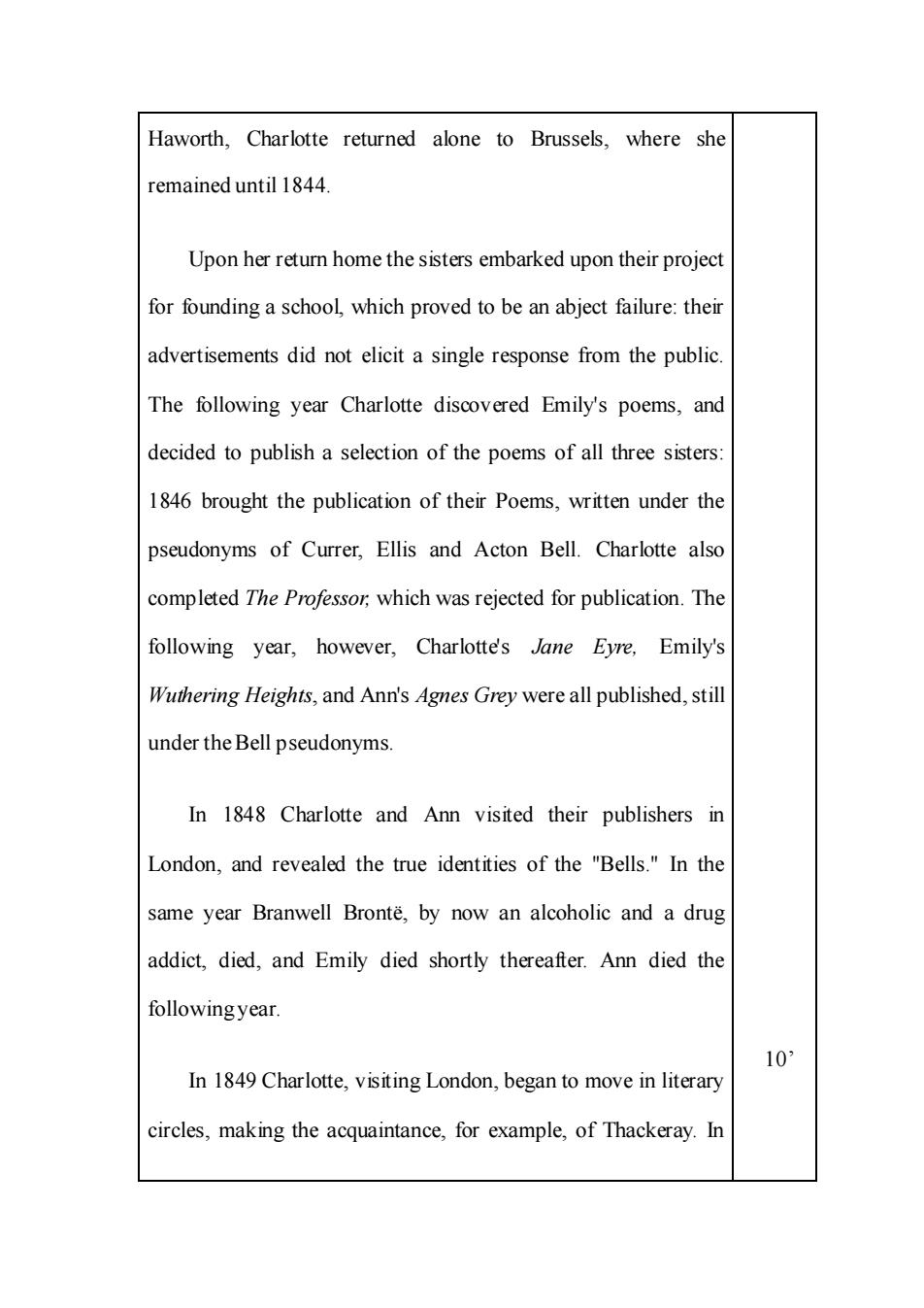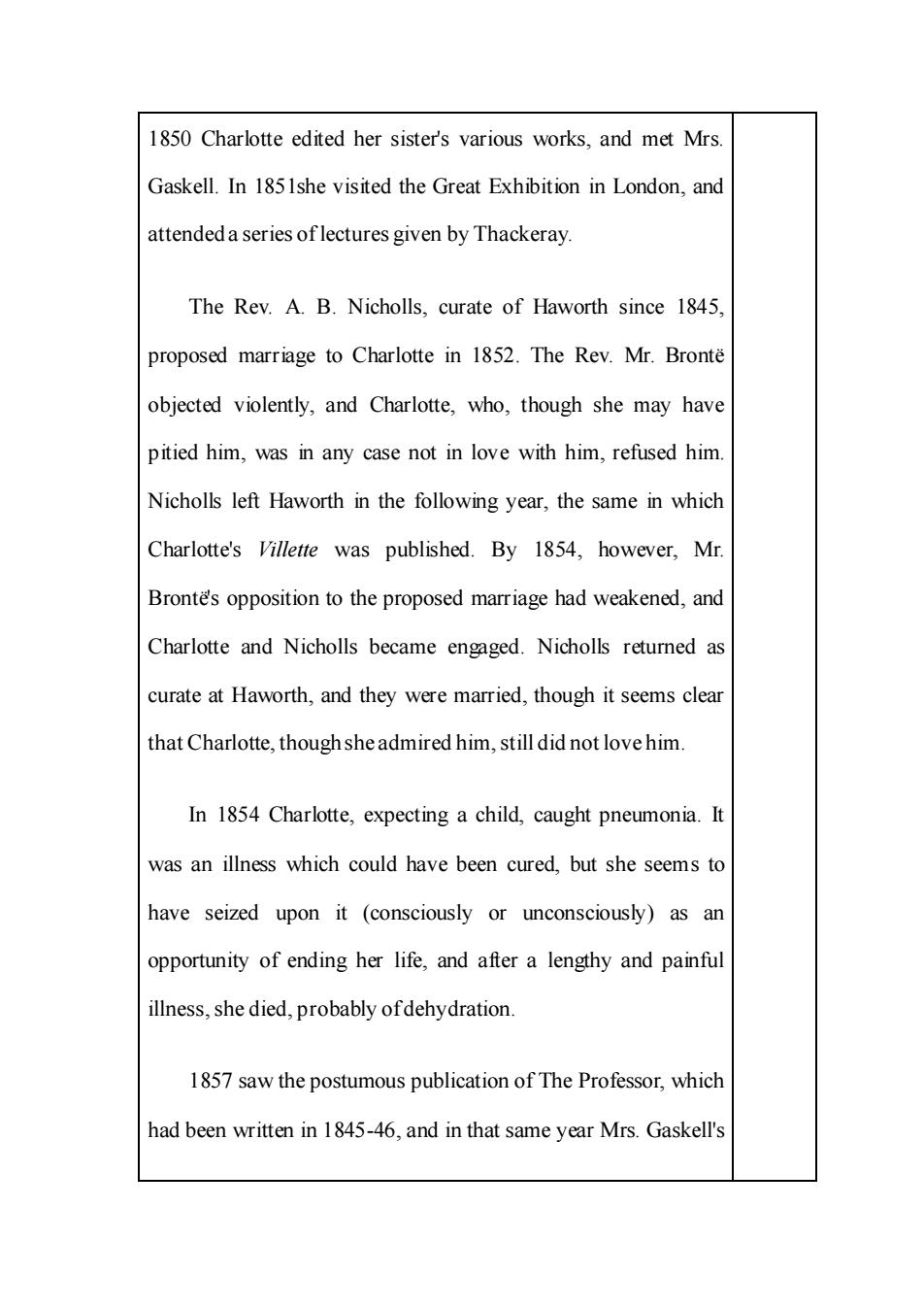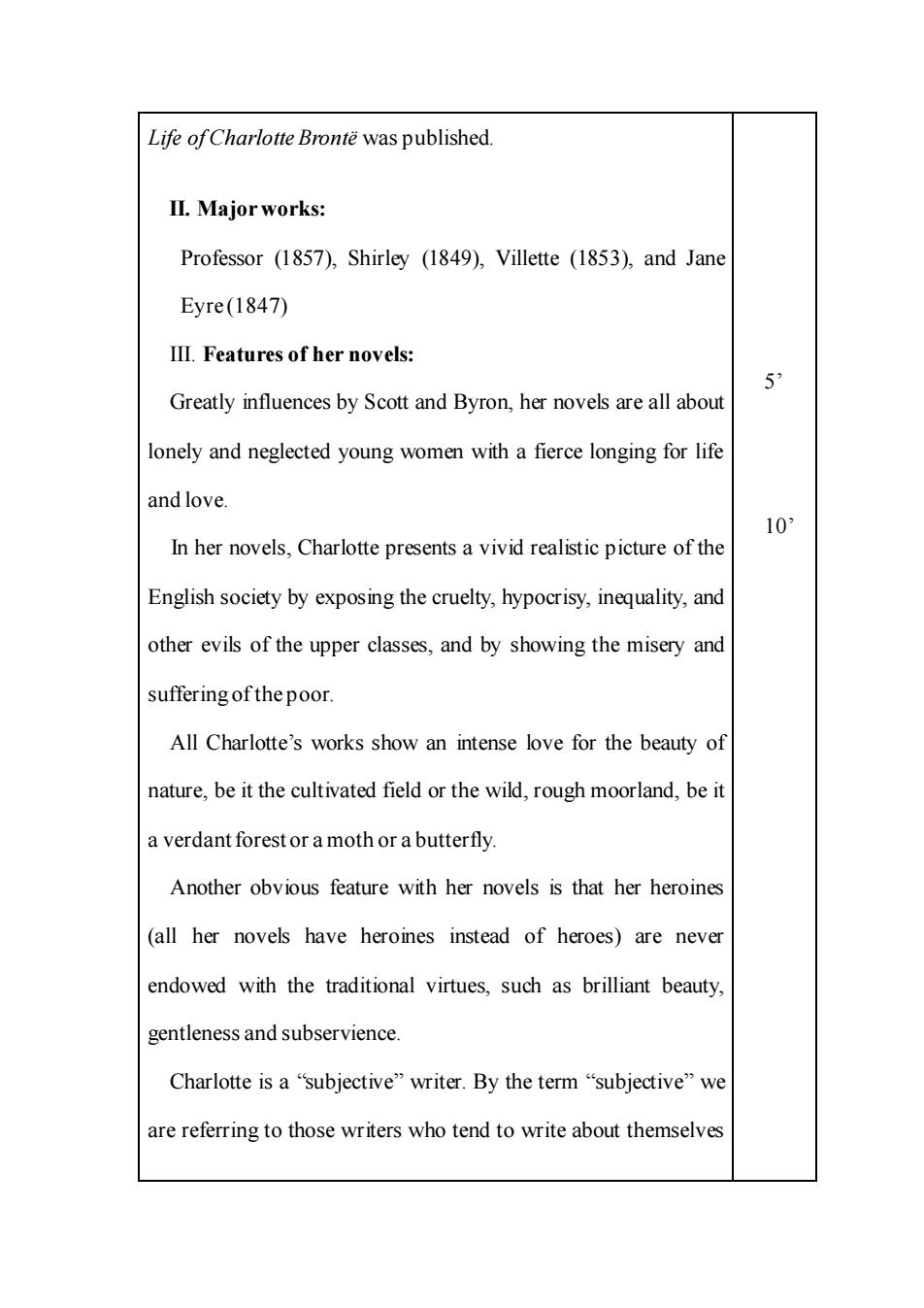
教案 课程名称 英国文学 授课专业和班级 英语本科 授课内容 Charlotte Bronte 授课学时 To let the students see the significance of literature. 教学目的 To let the students have the general impression of British literature. To let the students get basic knowledge of British literature To get to know the general clue of British literary history 教学重点与To get to know the important British writers and literary works 难点 To get to know some key terms To know some methods for literary appreciation and criticism 教学方法 82emmnds 辅助手段 Projector,audio-video machine L.Life Charlotte Bronte was born in 1816,the third daughter of the Rev.Patrick Bronte and his wife Maria.Her brother Patrick 10 Branwell was born in 1817,and her sisters Emily and Anne in 1818 and 1820.In 1820,too,the Bronte family moved to Haworth,Mrs.Bronte dyingthe followingyear. In 1824 the four eldest Bronte daughters were enrolled as pupils at the Clergy Daughter's School at Cowan Bridge.The following year Maria and Elizabeth,the two eldest daughters. became ill,left the school and died:Charlotte and Emily
教 案 课程名称 英国文学 授课专业和班级 英语本科 授课内容 Charlotte Bronte 授课学时 2 教学目的 To let the students see the significance of literature; To let the students have the general impression of British literature. To let the students get basic knowledge of British literature 教学重点与 难点 To get to know the general clue of British literary history To get to know the important British writers and literary works To get to know some key terms To know some methods for literary appreciation and criticism 教学方法 Open questions and answers in class Class discussion and analysis 辅助手段 Projector, audio-video machine I. Life Charlotte Brontë was born in 1816, the third daughter of the Rev. Patrick Brontë and his wife Maria. Her brother Patrick Branwell was born in 1817, and her sisters Emily and Anne in 1818 and 1820. In 1820, too, the Brontë family moved to Haworth, Mrs. Brontë dying the following year. In 1824 the four eldest Brontë daughters were enrolled as pupils at the Clergy Daughter's School at Cowan Bridge. The following year Maria and Elizabeth, the two eldest daughters, became ill, left the school and died: Charlotte and Emily, 10’

understandably,were brought home. In 1826 Mr.Bronte brought home a box of wooden soldiers for Branwell to play with.Charlotte,Emily,Branwell,and Ann playing with the soldiers,conceived of and began to write in great detail about an imaginary world which they called Angria. In 1831 Charlotte became a pupil at the school at Roe Head. but she left school the following year to teach her sisters at home She returned returns to Roe Head School in 1835 as a governess for a time her sister Emily attended the same school as a pupil but became homesick and returned to Haworth.Ann took her place from 1836 to 1837. In 1838,Charlotte left Roe Head School.In 1839 she accepted a position as governess in the Sidgewick family,but left after three months and returned to Haworth.In 1841 she became governess in the White family,but left,once again,after nine 10 months. Upon her return to Haworth the three sisters,led by Charlotte,decided to open their own school after the necessary preparations had been completed.In 1842 Charlotte and Emily went to Brussels to complete their studies.After a trip home to
understandably, were brought home. In 1826 Mr. Brontë brought home a box of wooden soldiers for Branwell to play with. Charlotte, Emily, Branwell, and Ann, playing with the soldiers, conceived of and began to write in great detail about an imaginary world which they called Angria. In 1831 Charlotte became a pupil at the school at Roe Head, but she left school the following year to teach her sisters at home. She returned returns to Roe Head School in 1835 as a governess: for a time her sister Emily attended the same school as a pupil, but became homesick and returned to Haworth. Ann took her place from 1836 to 1837. In 1838, Charlotte left Roe Head School. In 1839 she accepted a position as governess in the Sidgewick family, but left after three months and returned to Haworth. In 1841 she became governess in the White family, but left, once again, after nine months. Upon her return to Haworth the three sisters, led by Charlotte, decided to open their own school after the necessary preparations had been completed. In 1842 Charlotte and Emily went to Brussels to complete their studies. After a trip home to 10’

Haworth,Charlotte returned alone to Brussels,where she remained until 1844. Upon her retum home the sisters embarked upon their project for founding a school,which proved to be an abject failure:their advertisements did not elicit a single response from the public. The following year Charlotte discovered Emily's poems,and decided to publish a selection of the poems of all three sisters: 1846 brought the publication of their Poems,written under the pseudonyms of Currer,Ellis and Acton Bell.Charlotte also completed The Professor;which was rejected for publication.The following year,however,Charlottes Jane Eyre,Emily's Wuthering Heights,and Ann's Agnes Grey were all published,still under the Bell pseudonyms. In 1848 Charlotte and Ann visited their publishers in London,and revealed the true identities of the "Bells."In the same year Branwell Bronte,by now an alcoholic and a drug addict,died,and Emily died shortly thereafter.Ann died the following year. 10 In 1849 Charlotte,visiting London,began to move in literary circles,making the acquaintance,for example,of Thackeray.In
Haworth, Charlotte returned alone to Brussels, where she remained until 1844. Upon her return home the sisters embarked upon their project for founding a school, which proved to be an abject failure: their advertisements did not elicit a single response from the public. The following year Charlotte discovered Emily's poems, and decided to publish a selection of the poems of all three sisters: 1846 brought the publication of their Poems, written under the pseudonyms of Currer, Ellis and Acton Bell. Charlotte also completed The Professor, which was rejected for publication. The following year, however, Charlotte's Jane Eyre, Emily's Wuthering Heights, and Ann's Agnes Grey were all published, still under the Bell pseudonyms. In 1848 Charlotte and Ann visited their publishers in London, and revealed the true identities of the "Bells." In the same year Branwell Brontë, by now an alcoholic and a drug addict, died, and Emily died shortly thereafter. Ann died the following year. In 1849 Charlotte, visiting London, began to move in literary circles, making the acquaintance, for example, of Thackeray. In 10’

1850 Charlotte edited her sister's various works,and met Mrs Gaskell.In 1851she visited the Great Exhibition in London,and attended a series of lectures given by Thackeray. The Rev.A.B.Nicholls,curate of Haworth since 1845 proposed marriage to Charlotte in 1852.The Rev.Mr.Bronte objected violently,and Charlotte,who,though she may have pitied him,was in any case not in love with him,refused him. Nicholls left Haworth in the following year,the same in which Charlotte's Villette was published.By 1854,however,Mr. Brontes opposition to the proposed marriage had weakened,and Charlotte and Nicholls became engaged.Nicholls retumed as curate at Haworth,and they were married,though it seems clea that Charlotte,though sheadmired him,still did not love him. In 1854 Charlotte,expecting a child,caught pneumonia.It was an illness which could have been cured,but she seems to have seized upon it (consciously or unconsciously)as an opportunity of ending her life,and after a lengthy and painfu illness,she died,probably ofdehydration. 1857 saw the postumous publication of The Professor,which had been written in 1845-46,and in that same year Mrs.Gaskell's
1850 Charlotte edited her sister's various works, and met Mrs. Gaskell. In 1851she visited the Great Exhibition in London, and attended a series of lectures given by Thackeray. The Rev. A. B. Nicholls, curate of Haworth since 1845, proposed marriage to Charlotte in 1852. The Rev. Mr. Brontë objected violently, and Charlotte, who, though she may have pitied him, was in any case not in love with him, refused him. Nicholls left Haworth in the following year, the same in which Charlotte's Villette was published. By 1854, however, Mr. Brontë's opposition to the proposed marriage had weakened, and Charlotte and Nicholls became engaged. Nicholls returned as curate at Haworth, and they were married, though it seems clear that Charlotte, though she admired him, still did not love him. In 1854 Charlotte, expecting a child, caught pneumonia. It was an illness which could have been cured, but she seems to have seized upon it (consciously or unconsciously) as an opportunity of ending her life, and after a lengthy and painful illness, she died, probably of dehydration. 1857 saw the postumous publication of The Professor, which had been written in 1845-46, and in that same year Mrs. Gaskell's

Life ofCharlotte Bronte was published II.Major works: Professor (1857),Shirley (1849),Villette (1853),and Jane Eyre(1847) III.Features of her novels: 5 Greatly influences by Scott and Byron,her novels are all about lonely and neglected young women with a fierce longing for life and love. ⊙ In her novels,Charlotte presents a vivid realistic picture of the English society by exposing the cruelty,hypocrisy,inequality,and other evils of the upper classes,and by showing the misery and suffering of the poor. All Charlotte's works show an intense love for the beauty of nature,be it the cultivated field or the wild,rough moorland,be it a verdant forest or a moth or a butterfly. Another obvious feature with her novels is that her heroines (all her novels have heroines instead of heroes)are neve endowed with the traditional virtues,such as brilliant beauty, gentleness and subservience. Charlotte is a“subjective”writer.By the term“subjective”we are referring to those writers who tend to write about themselves
Life of Charlotte Brontëwas published. II. Major works: Professor (1857), Shirley (1849), Villette (1853), and Jane Eyre (1847) III. Features of her novels: Greatly influences by Scott and Byron, her novels are all about lonely and neglected young women with a fierce longing for life and love. In her novels, Charlotte presents a vivid realistic picture of the English society by exposing the cruelty, hypocrisy, inequality, and other evils of the upper classes, and by showing the misery and suffering of the poor. All Charlotte’s works show an intense love for the beauty of nature, be it the cultivated field or the wild, rough moorland, be it a verdant forest or a moth or a butterfly. Another obvious feature with her novels is that her heroines (all her novels have heroines instead of heroes) are never endowed with the traditional virtues, such as brilliant beauty, gentleness and subservience. Charlotte is a “subjective” writer. By the term “subjective” we are referring to those writers who tend to write about themselves 5’ 10’